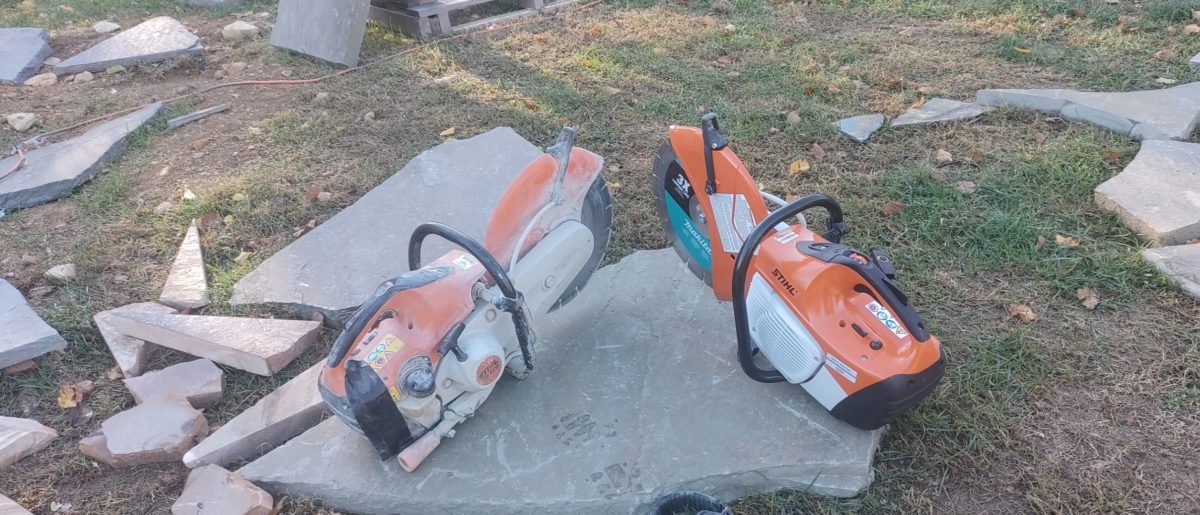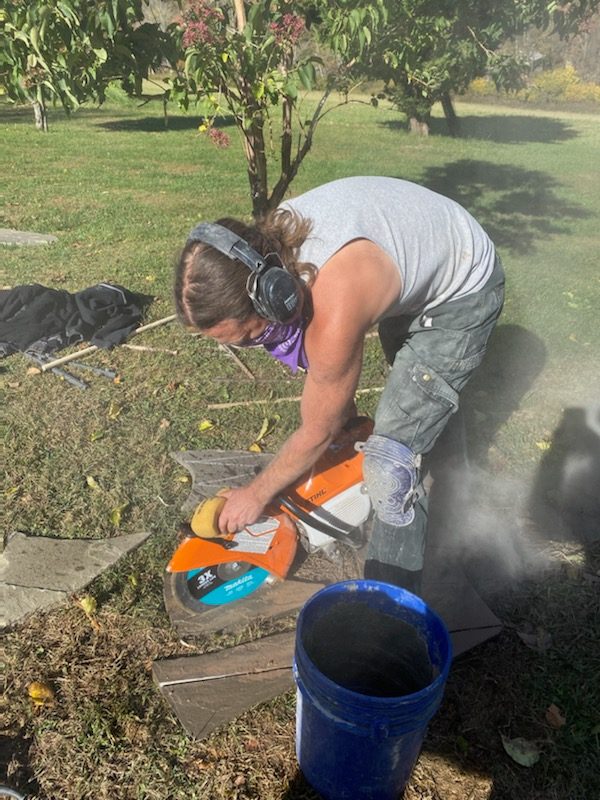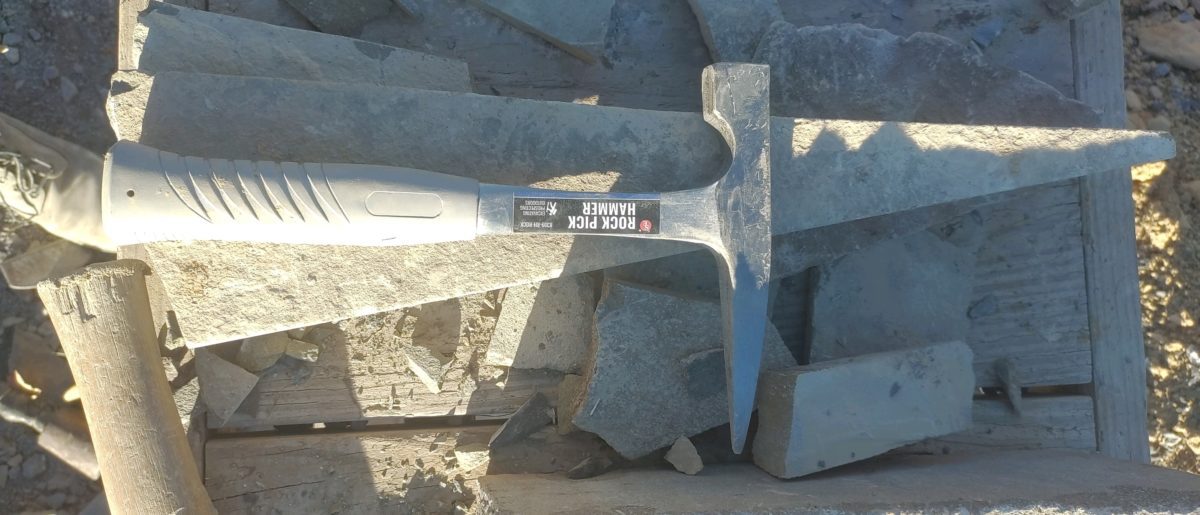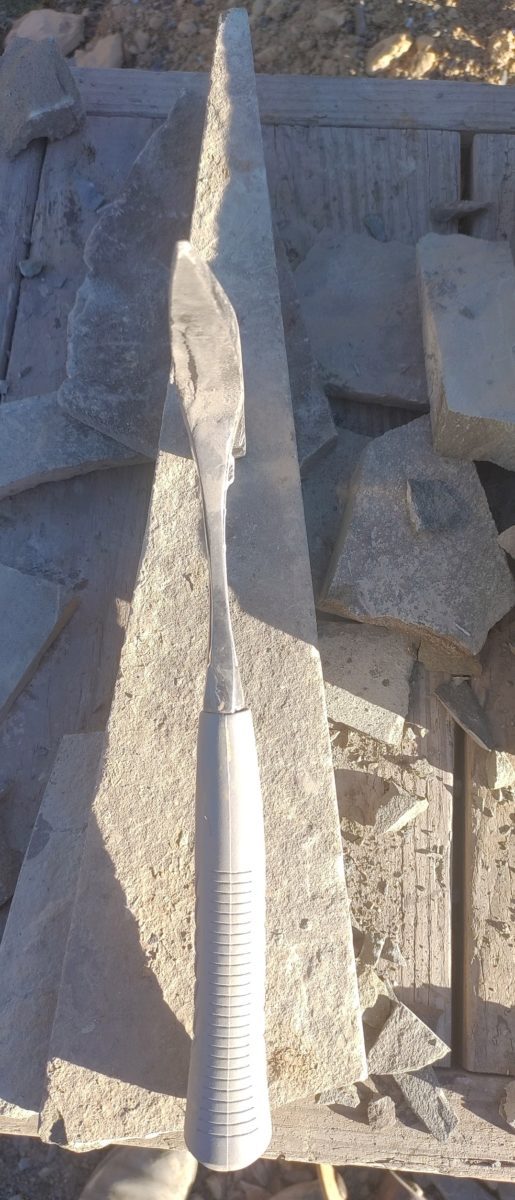Hello everybody, I’m Devin Devine and welcome to another edition of Stone Art Chronicles, the adventure continues. Today we’re going to talk about stone saws.
Q: should a dry stone mason be allowed to use modern power tools?
Oh, you need to ask better questions than that….

Maybe you have some power tools that have lasted you over a decade. Then again, if you’re a contractor and you’ve watched countless grinders, drills and saws die out on after a year or two, then perhaps you’ve come to greatly value any tool that just lasts and lasts.
I got 12 full years of usage out of my last stihl 420 stone saw. IDK, might be a record! So when the saw finally spun its last the other day, I wasn’t angry. Admittedly there was an idk-how-many year span of barely using the saw and mostly just bringing the saw in as a last ditch back-up. But 12 years of good, reliable use. Sure, many of those years were light-duty usage, because using the saw can be a mixed blessing. Noisey and dusty, not very eco or very old school…we avoid them when we can. For example, for wall building, we’ll bring the saw, but maybe use it twice for an entire wall project. But on the positive side: a 14″ stone saw sure can make some fast cuts.
Stone saws are valuable tools, but you should ALSO learn how to get by without one. Related Content:
- how to cut flagstone using a hammer
- how to split boulders using masonry cut-nails
- splitting boulders with feather and wedge
For minor cuts in flagstone, for example, where I only need to remove maybe an inch or two from the edge of the stone–I’ll knap. That is, I’ll draw a line where the stone needs to be removed and then I’ll use a regular steel brick hammer to remove it, bit by bit, as described in the first of those 3 links.
And to cut a large boulder in half, or to split a thick slab where the edge needn’t be perfect, the feather and wedge method and/or the cut-nail method is preferred over the stone saw. It’s faster and less noisey, plus leaves an attractive rock face with drill lines, rather than an unappealing sawn-face, which is generally not usable, without needing to be surfaces or rock-faced, torched, polished, bushed, or otherwise dressed.
I’ve owned a wacker bts 1035. Around 18 years ago there was a situation where makita, wacker and one other company were all selling the exact same saw, just re-housing it. It was a decent unit, but when one of my workers put straight gas into it one time, I had to replace it with the stihl. The wacker did the job just fine, but the stihl is lighter and easier to use.
I’ve owned a husqvarna k770 too, but that one died before its time, through no fault of the manufacturer.
Is the stihl 420 saw the best gas powered stone saw?
The general consensus amongst masons is yes. During the late 2010’s I was hearing an good amount of praise for the husky k770. The one I briefly owned seemed a solid tool, quite comparable to the stihl in most ways. The difference: stihl is easier to wield, more comfortable to work with. One pound lighter and balanced better, makes a real difference. Combine that with the stihl ts 420’s reputation for longevity and we do have a winner.

Always cut wet when possible. Introducing the Grout Sponge Technique ™
Disclaimer: don’t you people go trying this at home, that man is a trained professional.
The quick disconnect water hookups always break, is why I need to bring up these various methods
I’ve seen other guys use the hose on mister, laid down next to the cut spot. Some guys will waste time by having a second guy, standing by holding the hose. Then there’s the bucket/hole technique. You take a bucket and drill a hole in the side so water spouts out of it right to the cut spot. This is a decent method and you can plug the hole with a random sliver of wood chip, when not cutting. Weirdly, I’ve never seen any one use the grout sponge in the left hand while you’re cutting method. Well, except for my own workers. Fact is, it’s the best method around, for when the water hookup is on the fritz or a hose isn’t nearby.
Another mason recently suggested replacing the plastic water connect on the saw, with brass fittings. Will update this post with photos, after implementing this one.
The secret to keeping your gas “chop” saw/concrete saw/cut-off saw* running for many many years?
- Dust prevention. It is the dust, ultimately, that usually kills these saws. Use water. Use the hose attachment when possible and use another method if need be. Failing at that, use a fan. The thing about using water is it extends the life of the blade (not a small expense) it extends the life of the saw, and it extends the life of your lungs, and that aint no joke.
- Fuel, avoid ethanol. I already told you that I’ve seen 2 saws brutally cut down in their primes, due to wrong fuel being used. So use mixed gas, sure. But the gas you buy at the pump, it has ethanol. 2 cycle engines like these stone saws do not like ethanol. So buy the premixed cans of mixed gas. Not cheap, but your stone saw will run better and last longer. Buying gas and filling a can with it, then adding your 2 cycle oil to it–that’s life is over and done. I just saw it for likebut don’t pay 60 dollars for like a quart– $60 on amazon! So buyer beware, you can get the stuff for $26 per gallon at depot/lowes/tractor supply.
- Filters. Clean out the filters once a month if you use a lot of chisels–or once a week if your like a paver guy, constantly running the saw. Replace the filters often enough. Cutting dry, without water, will make you need to replace the filter more often. Replace fuel filter “often enough”, maybe at every other air filter change.
- Just simply know how to start it right, don’t leave it in the rain, and stay up on routine maintenance, that’s it. Start up procedure: push the bubble in once, pull the string once while on choke. Next pull should either be at half choke, or at no choke. The saw will tell you whether it needs half choke or choke off. Usually you can tell be feel/by sound. The second pull should get it started. My old unit was a 2 or 3 pull startup, right up until the very end. Except of course when it was behind on maintenance.
The TL;DR = stihl 420 is your best bet and you best cut it wet
*Look, we’re talking about 14″ diamond blade saws, usually 2 cycle engines–they go by many names. I usually just call it the gas saw. For this article I called it the stone saw, trying to be search engine friendly. The name “cut off saw, or worst still “cut saw” is silly to me. All saws cut, come on people.

I got a new hammer! Just a 22 ounce rock stinger. Like a brick hammer, but instead of a blade edge on the one side, it’s a point. The point of this hammer, is for making minor removals of lumps or what-not. I’m reaching for this, mostly instead of using a point chisel, mostly because it’s faster to just swing a hammer, without bringing a chisel into play.

So I’m always excited to have a new hammer…do I need it, when point chisels work just fine, and better in many cases? Well I don’t know, yet! I don’t know if you can tell from the photo, but the hammer came from amazon just slightly bent! Swinging it a few times, it works and does about what I expect it to, but then it feels a slight bit off–cause there’s a bend! Oh well, I’m taking a few days off (sort of, but then I do have a bench to deliver tomorrow) for the holiday (we worked through the weekend). When I get back to the jobsite, we’ll bend it back, do some stone smacking, it’ll be alright.
I may have to get a Mallorcan walling hammer from t&h. Seems like a heavier duty tool that would serve the same purpose. I suspect it will do this hammer’s job, but better. But idk, if this one will be useful for walling and/or for roughing out.
That’s it for today my friends. Check back next month, a new dry stone sculpture and some landscaping stone art will be revealed. Be there!
Thank you
![]()
Trackbacks/Pingbacks